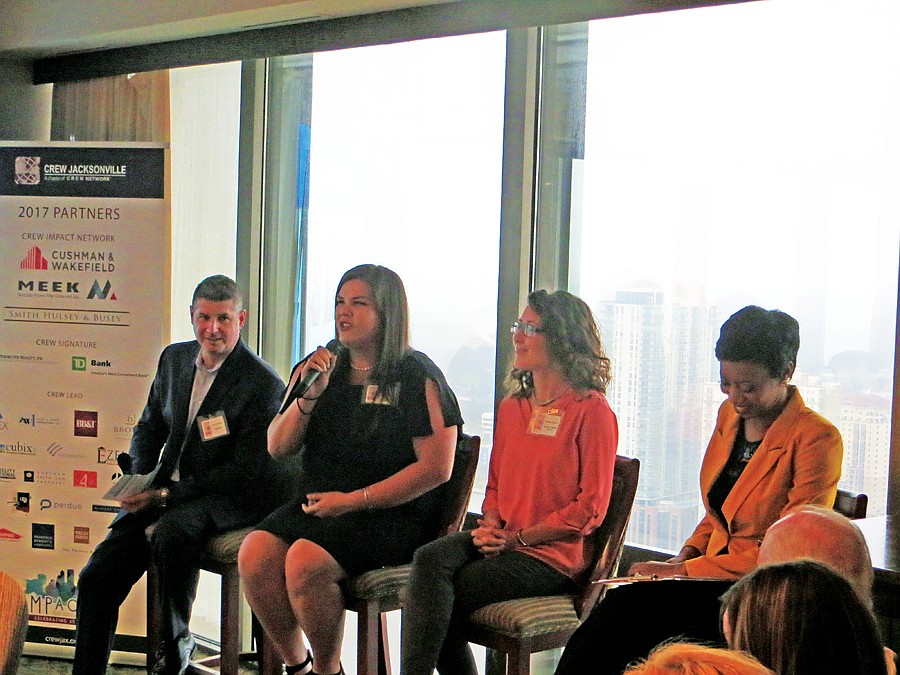
Millennials have surpassed baby boomers in terms of population. And they, along with the advancements in technology that facilitate it, are influencing the way companies organize their workforce and office environments.
With an increasing number of baby boomers approaching retirement age, employers are looking at ways to attract, and retain, the next wave of employees. One in three American workers are millennials, according to a 2015 Pew Research Center analysis of U.S. Census Bureau data. Research also shows that millennials are seeking a significantly different workplace environment from that of their predecessors, especially in two key areas: opportunity and choice.
How millennials will impact and influence the work place in the present and for years to come was the topic of discussion at “Millennials in the Workplace,” a panel event hosted by CREW Jacksonville in June.
Panelists John Trevathan, vice president corporate services for Florida Blue; Bridget Wenrich, interior designer at Gresham Smith & Partners; and Kathleen Krilanovich, a research analyst with commercial real estate services company Cushman & Wakefield, discussed how employers can make the most of the talents millennials offer.
The way millennials have learned, gone to school, been educated — even the way they socialize — is having a profound influence on how work is done and is driving the demand for more workplace options, Trevathan said. They seek opportunities to collaborate, desire instant feedback and they prefer the option to choose alternative workplaces, he said.
To meet this shift, health insurance provider Florida Blue’s offices are undergoing a redesign to include an open office concept while still offering individual workstations for employees who prefer to have their own space. Formal meeting areas, such as conference rooms, still will be incorporated, but the trend is toward more informal collaborative spaces including lounge areas or huddle stations where employees can meet one-on-one or in small group configurations.
Florida Blue also is installing height-adjustable workstations, which Wenrich said are gaining popularity in contemporary office environments. “Stand-up desks” provide options to sitting all day, which appeals to younger employees who lean toward more health-conscious practices.
“It encourages people to stand up and work rather than sit for eight hours, which they say is the new smoking,” Wenrich said of the acknowledged health disadvantages of traditional workspace design.
Stand-up workspaces also help facilitate an improved work/life balance, Krilanovich said. Rather than being slumped over a desk all day, the ability to stand up and work, she said, not only enhances productivity but also leaves workers more energized at the end of the day.
An open office also can have a positive impact on the work environment, the panelists agree. After Cushman & Wakefield’s Orlando office underwent a redesign, Krilanovich noted an increase in morale.
“We all seem more connected,” she said.
“What I find with people in general is if you can find a common goal and get people motivated, they will produce.”
Kathleen Krilanovich
Research analyst with commercial real estate services company Cushman & Wakefield
As technology improves and becomes more portable, workstations are shrinking inside as well. In fact, individual workstations may not be needed at all — for some at least.
As more employees telecommute, their workstation footprint is significantly smaller. When companies do not need to provide a workstation for every employee every day, that decreases their need for real estate and parking accommodations, Wenrich said.
Millennials also are more likely to use public transportation, and many prefer to live in urban areas near their workplace, allowing them to walk or bike to work.
Further reducing the corporate footprint, Florida Blue’s Trevathan said the company has embraced “print anywhere” technology, which allows employees to print to any printer, anywhere in the office. Along with convenience, the practice reduces the number of printers required.
Some employers, the panelists said, possess the misconception that the millennial mindset equates to disloyalty. Conversely, Krilanovich argued, they want to be contributors, be difference-makers and support their employers’ efforts.
Rather than disloyalty, she said, millennials want opportunity, and in that respect, they are no different from other generations of workers.
“What I find with people in general is if you can find a common goal and get people motivated, they will produce,” she said.
Krilanovich also recommends transparency. Managers should be upfront about a timeline for advancement, adding that the total package the company offers is of more value than its individual parts.
“It’s not always about titles and money,” Krilanovich said. Offering incentives such as extended paid time off or the opportunity to work from home, for example, as well as the opportunity for greater responsibility can be enticing.
On the heels of millennials will be Generation Z. In many ways, Krilanovich said, that next generation of employees will be quite different. Rather than social collaborators, they tend to be more introverted, she said, and from a workspace design standpoint, they prefer dark spaces.
Planning for this next wave of workers was considered during Florida Blue’s overhaul, Trevathan said.
Agility and the flexibility to repurpose space are critical elements in office design because, he stressed, Generation Z will have as much influence on the workplace environment as have millennials.
What both generations are teaching corporate management, Trevathan added, is the recognition that, perhaps unlike past generations work, cannot consume people’s lives. “Flexible work arrangements, the ability to manage your day and get a work/life balance out of your career are very, very important,” he said.
Wenrich added she hoped the takeaway from the discussion was that change can be beneficial. “Change actually means that we’re growing and that we’re evolving,” she said.